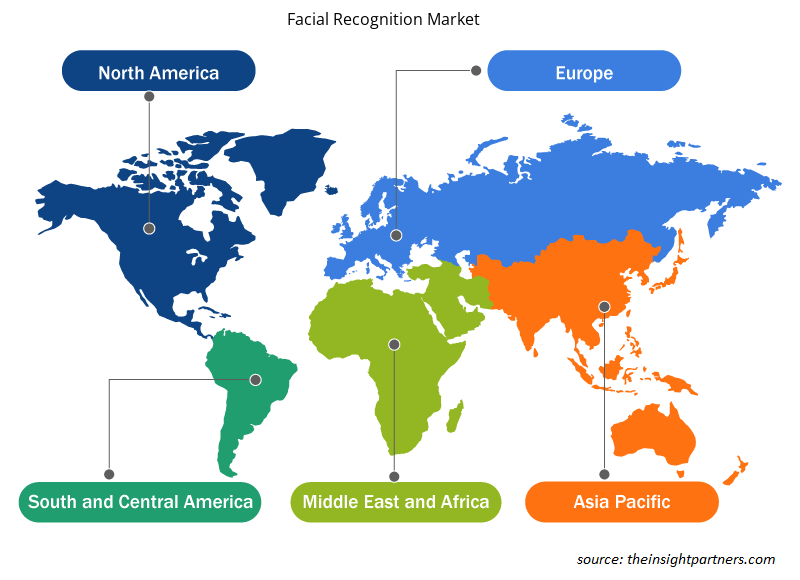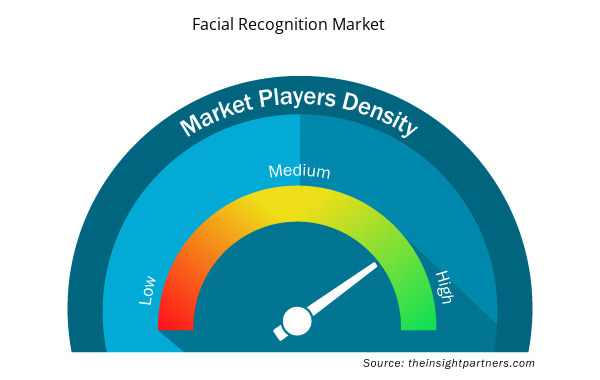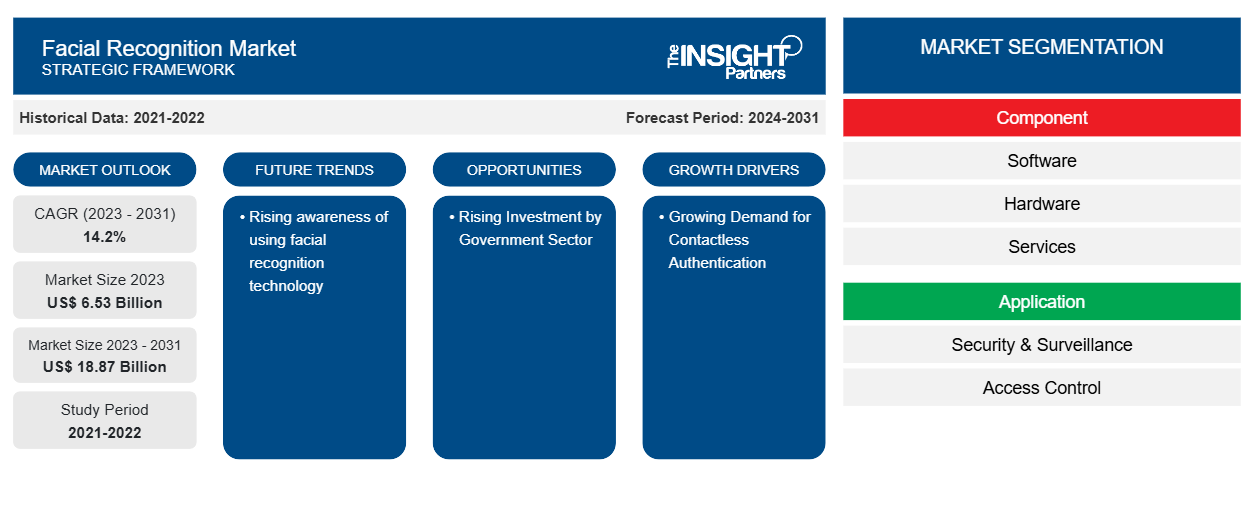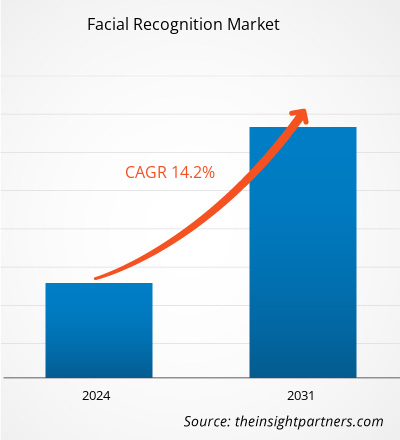Se proyecta que el tamaño del mercado de reconocimiento facial alcance los 18.870 millones de dólares estadounidenses en 2031, frente a los 6.530 millones de dólares estadounidenses en 2023. Se espera que el mercado registre una CAGR del 14,2 % durante el período 2023-2031.Es probable que la creciente conciencia sobre el uso de la tecnología de reconocimiento facial siga siendo una tendencia clave en el mercado.
Análisis del mercado de reconocimiento facial
La creciente demanda de sistemas de videovigilancia eficaces está impulsando la demanda de tecnologías de reconocimiento facial. La tecnología de reconocimiento facial está siendo adoptada por sectores como la seguridad y la aplicación de la ley, la atención sanitaria, el comercio minorista y el transporte para mejorar la seguridad.
Descripción general del mercado de reconocimiento facial
El reconocimiento facial es un tipo de software biométrico que utiliza los rasgos faciales de una persona para verificar su identificación. El reconocimiento facial es un método típico utilizado en sistemas de seguridad para identificar a personas o usuarios específicos. Una de las aplicaciones más frecuentes del reconocimiento facial es desbloquear teléfonos celulares. La técnica también se utiliza en la aplicación de la ley por parte de la policía, la vigilancia por video y el control de pasajeros. El reconocimiento facial mapea matemáticamente las características faciales de una persona y almacena los resultados como una huella facial. Para validar la identificación de un individuo, el programa compara un video o una imagen digital distintos con una base de datos de huellas faciales almacenadas utilizando técnicas de aprendizaje profundo.
Personalice este informe según sus necesidades
Obtendrá personalización en cualquier informe, sin cargo, incluidas partes de este informe o análisis a nivel de país, paquete de datos de Excel, así como también grandes ofertas y descuentos para empresas emergentes y universidades.
- Obtenga las principales tendencias clave del mercado de este informe.Esta muestra GRATUITA incluirá análisis de datos, desde tendencias del mercado hasta estimaciones y pronósticos.
Factores impulsores y oportunidades del mercado del reconocimiento facial
La creciente demanda de autenticación sin contacto favorecerá al mercado
La creciente necesidad de técnicas de autenticación sin contacto, junto con la disponibilidad de cámaras de alta resolución y el uso cada vez mayor de teléfonos inteligentes equipados con capacidades de reconocimiento facial, está impulsando la industria del reconocimiento facial. Esta tecnología tiene usos en una variedad de industrias, incluidas la vigilancia, la banca, los aeropuertos y el control de acceso . Se estima que el mercado generará grandes ingresos y seguirá creciendo en los próximos años.
Aumento de la inversión por sector público
El segmento gubernamental está compuesto por diversas instalaciones gubernamentales, instalaciones de defensa, municipios, estaciones de servicios públicos y otros. Debido al creciente énfasis en la seguridad nacional, los gobiernos de todo el mundo están invirtiendo significativamente en soluciones de seguridad avanzadas , como los sistemas de reconocimiento facial. Además, el creciente énfasis en el desarrollo de ciudades inteligentes es uno de los otros factores que contribuyen a la adopción de sistemas de reconocimiento facial para aplicaciones de seguridad y vigilancia mejoradas, lo que impulsa el crecimiento del mercado del reconocimiento facial.
Análisis de segmentación del informe de mercado de reconocimiento facial
Los segmentos clave que contribuyeron a la derivación del análisis del mercado de reconocimiento facial son el componente, la aplicación y la vertical.
- Según los componentes, el mercado está segmentado en software, hardware y servicios. El segmento de hardware tuvo una participación de mercado significativa en 2023.
- Según la aplicación, el mercado se segmenta en seguridad y vigilancia, control de acceso y otros. El segmento de seguridad y vigilancia tuvo una mayor participación de mercado en 2023.
- Según el sector vertical, el mercado está segmentado en BFSI, comercio minorista y electrónico, gobierno, atención médica, educación, automoción y transporte, entre otros. El segmento BFSI tuvo la mayor participación del mercado en 2023.
Análisis de la cuota de mercado del reconocimiento facial por geografía
El alcance geográfico del informe del mercado de reconocimiento facial se divide principalmente en cinco regiones: América del Norte, Asia Pacífico, Europa, Medio Oriente y África, y América del Sur y Central.
En 2023, el mercado se ubicó en América del Norte, por lo que se espera que cualquier impacto en el crecimiento de las industrias afecte negativamente al crecimiento económico de la región. A pesar de que existen varias regulaciones estatales y locales que regulan la tecnología de reconocimiento facial en Estados Unidos, persisten los conflictos inminentes. Se prevé que el reconocimiento facial aumente significativamente en los próximos años debido al aumento de la inversión y el entusiasmo de las empresas por adoptarlo. Al mismo tiempo, los legisladores estadounidenses y los grupos de privacidad están expresando su preocupación por los posibles efectos sociales de la tecnología y abogando por una mayor regulación.
Perspectivas regionales del mercado de reconocimiento facial
Los analistas de Insight Partners explicaron en detalle las tendencias y los factores regionales que influyen en el mercado de reconocimiento facial durante el período de pronóstico. Esta sección también analiza los segmentos y la geografía del mercado de reconocimiento facial en América del Norte, Europa, Asia Pacífico, Oriente Medio y África, y América del Sur y Central.

- Obtenga datos regionales específicos para el mercado de reconocimiento facial
Alcance del informe de mercado de reconocimiento facial
| Atributo del informe | Detalles |
|---|---|
| Tamaño del mercado en 2023 | 6.530 millones de dólares estadounidenses |
| Tamaño del mercado en 2031 | US$ 18.87 mil millones |
| CAGR global (2023 - 2031) | 14,2% |
| Datos históricos | 2021-2022 |
| Período de pronóstico | 2024-2031 |
| Segmentos cubiertos | Por componente
|
| Regiones y países cubiertos | América del norte
|
| Líderes del mercado y perfiles de empresas clave |
|
Densidad de actores del mercado de reconocimiento facial: comprensión de su impacto en la dinámica empresarial
El mercado de reconocimiento facial está creciendo rápidamente, impulsado por la creciente demanda de los usuarios finales debido a factores como la evolución de las preferencias de los consumidores, los avances tecnológicos y una mayor conciencia de los beneficios del producto. A medida que aumenta la demanda, las empresas amplían sus ofertas, innovan para satisfacer las necesidades de los consumidores y aprovechan las tendencias emergentes, lo que impulsa aún más el crecimiento del mercado.
La densidad de actores del mercado se refiere a la distribución de las empresas o firmas que operan dentro de un mercado o industria en particular. Indica cuántos competidores (actores del mercado) están presentes en un espacio de mercado determinado en relación con su tamaño o valor total de mercado.
Las principales empresas que operan en el mercado de reconocimiento facial son:
- Tecnología 5
- IDEMIA
- Consciente Inc.
- Cognitec Systems GmbH
- Corporación Ayonix
- Fujitsu limitada
Descargo de responsabilidad : Las empresas enumeradas anteriormente no están clasificadas en ningún orden particular.

- Obtenga una descripción general de los principales actores clave del mercado de reconocimiento facial
Noticias y desarrollos recientes del mercado de reconocimiento facial
El mercado del reconocimiento facial se evalúa mediante la recopilación de datos cualitativos y cuantitativos a partir de investigaciones primarias y secundarias, que incluyen publicaciones corporativas importantes, datos de asociaciones y bases de datos. A continuación, se enumeran algunos de los avances en el mercado del reconocimiento facial:
- IDEMIA ha presentado VisionPass SP, su última solución de reconocimiento facial para el control de acceso. IDEMIA ha ampliado su oferta de productos con VisionPass SP, un terminal elegante y compacto con un diseño ecológico que proporciona resultados de comparación precisos y justos. (Fuente: IDEMIA, comunicado de prensa, enero de 2024)
- BAXE y Haventec se asociaron con IDEMIA para lanzar el primer ecosistema blockchain que utiliza una solución de autenticación facial para la identificación. (Fuente: BAXE, comunicado de prensa, enero de 2022)
Informe sobre el mercado de reconocimiento facial: cobertura y resultados
El informe “Tamaño y pronóstico del mercado de reconocimiento facial (2021-2031)” proporciona un análisis detallado del mercado que cubre las siguientes áreas:
- Tamaño del mercado de reconocimiento facial y pronóstico a nivel global, regional y nacional para todos los segmentos clave del mercado cubiertos bajo el alcance
- Tendencias del mercado de reconocimiento facial, así como dinámicas del mercado, como impulsores, restricciones y oportunidades clave
- Análisis detallado de las cinco fuerzas de Porter y PEST y FODA
- Análisis del mercado de reconocimiento facial que cubre las tendencias clave del mercado, el marco global y regional, los principales actores, las regulaciones y los desarrollos recientes del mercado
- Panorama de la industria y análisis de la competencia que abarca la concentración del mercado, análisis de mapas de calor, actores destacados y desarrollos recientes para el mercado de reconocimiento facial
- Perfiles detallados de empresas
- Análisis histórico (2 años), año base, pronóstico (7 años) con CAGR
- Análisis PEST y FODA
- Tamaño del mercado Valor/volumen: global, regional, nacional
- Industria y panorama competitivo
- Conjunto de datos de Excel



Report Coverage
Revenue forecast, Company Analysis, Industry landscape, Growth factors, and Trends

Segment Covered
This text is related
to segments covered.

Regional Scope
North America, Europe, Asia Pacific, Middle East & Africa, South & Central America

Country Scope
This text is related
to country scope.
Preguntas frecuentes
North America dominated the facial recognition market in 2023.
The growing requirement for effective video surveillance systems is driving up demand for facial recognition technologies. Facial recognition technology is being adopted by industries such as security and law enforcement, healthcare, retail, and transportation to improve security and safety.
The rising awareness of using facial recognition technology is likely to remain a key trend in the market.
Tech5, IDEMIA, Aware Inc., Cognitec Systems GmbH, and Ayonix Corporation are among the leading facial recognition market.
The estimated value of the facial recognition market is expected to reach US$ 18.87 billion by 2031.
The market is expected to grow at a CAGR of 14.2% over the forecast period.
Trends and growth analysis reports related to Technology, Media and Telecommunications : READ MORE..
The Insight Partners performs research in 4 major stages: Data Collection & Secondary Research, Primary Research, Data Analysis and Data Triangulation & Final Review.
- Data Collection and Secondary Research:
As a market research and consulting firm operating from a decade, we have published and advised several client across the globe. First step for any study will start with an assessment of currently available data and insights from existing reports. Further, historical and current market information is collected from Investor Presentations, Annual Reports, SEC Filings, etc., and other information related to company’s performance and market positioning are gathered from Paid Databases (Factiva, Hoovers, and Reuters) and various other publications available in public domain.
Several associations trade associates, technical forums, institutes, societies and organization are accessed to gain technical as well as market related insights through their publications such as research papers, blogs and press releases related to the studies are referred to get cues about the market. Further, white papers, journals, magazines, and other news articles published in last 3 years are scrutinized and analyzed to understand the current market trends.
- Primary Research:
The primarily interview analysis comprise of data obtained from industry participants interview and answers to survey questions gathered by in-house primary team.
For primary research, interviews are conducted with industry experts/CEOs/Marketing Managers/VPs/Subject Matter Experts from both demand and supply side to get a 360-degree view of the market. The primary team conducts several interviews based on the complexity of the markets to understand the various market trends and dynamics which makes research more credible and precise.
A typical research interview fulfils the following functions:
- Provides first-hand information on the market size, market trends, growth trends, competitive landscape, and outlook
- Validates and strengthens in-house secondary research findings
- Develops the analysis team’s expertise and market understanding
Primary research involves email interactions and telephone interviews for each market, category, segment, and sub-segment across geographies. The participants who typically take part in such a process include, but are not limited to:
- Industry participants: VPs, business development managers, market intelligence managers and national sales managers
- Outside experts: Valuation experts, research analysts and key opinion leaders specializing in the electronics and semiconductor industry.
Below is the breakup of our primary respondents by company, designation, and region:

Once we receive the confirmation from primary research sources or primary respondents, we finalize the base year market estimation and forecast the data as per the macroeconomic and microeconomic factors assessed during data collection.
- Data Analysis:
Once data is validated through both secondary as well as primary respondents, we finalize the market estimations by hypothesis formulation and factor analysis at regional and country level.
- Macro-Economic Factor Analysis:
We analyse macroeconomic indicators such the gross domestic product (GDP), increase in the demand for goods and services across industries, technological advancement, regional economic growth, governmental policies, the influence of COVID-19, PEST analysis, and other aspects. This analysis aids in setting benchmarks for various nations/regions and approximating market splits. Additionally, the general trend of the aforementioned components aid in determining the market's development possibilities.
- Country Level Data:
Various factors that are especially aligned to the country are taken into account to determine the market size for a certain area and country, including the presence of vendors, such as headquarters and offices, the country's GDP, demand patterns, and industry growth. To comprehend the market dynamics for the nation, a number of growth variables, inhibitors, application areas, and current market trends are researched. The aforementioned elements aid in determining the country's overall market's growth potential.
- Company Profile:
The “Table of Contents” is formulated by listing and analyzing more than 25 - 30 companies operating in the market ecosystem across geographies. However, we profile only 10 companies as a standard practice in our syndicate reports. These 10 companies comprise leading, emerging, and regional players. Nonetheless, our analysis is not restricted to the 10 listed companies, we also analyze other companies present in the market to develop a holistic view and understand the prevailing trends. The “Company Profiles” section in the report covers key facts, business description, products & services, financial information, SWOT analysis, and key developments. The financial information presented is extracted from the annual reports and official documents of the publicly listed companies. Upon collecting the information for the sections of respective companies, we verify them via various primary sources and then compile the data in respective company profiles. The company level information helps us in deriving the base number as well as in forecasting the market size.
- Developing Base Number:
Aggregation of sales statistics (2020-2022) and macro-economic factor, and other secondary and primary research insights are utilized to arrive at base number and related market shares for 2022. The data gaps are identified in this step and relevant market data is analyzed, collected from paid primary interviews or databases. On finalizing the base year market size, forecasts are developed on the basis of macro-economic, industry and market growth factors and company level analysis.
- Data Triangulation and Final Review:
The market findings and base year market size calculations are validated from supply as well as demand side. Demand side validations are based on macro-economic factor analysis and benchmarks for respective regions and countries. In case of supply side validations, revenues of major companies are estimated (in case not available) based on industry benchmark, approximate number of employees, product portfolio, and primary interviews revenues are gathered. Further revenue from target product/service segment is assessed to avoid overshooting of market statistics. In case of heavy deviations between supply and demand side values, all thes steps are repeated to achieve synchronization.
We follow an iterative model, wherein we share our research findings with Subject Matter Experts (SME’s) and Key Opinion Leaders (KOLs) until consensus view of the market is not formulated – this model negates any drastic deviation in the opinions of experts. Only validated and universally acceptable research findings are quoted in our reports.
We have important check points that we use to validate our research findings – which we call – data triangulation, where we validate the information, we generate from secondary sources with primary interviews and then we re-validate with our internal data bases and Subject matter experts. This comprehensive model enables us to deliver high quality, reliable data in shortest possible time.


 Obtenga una muestra gratuita de este informe
Obtenga una muestra gratuita de este informe